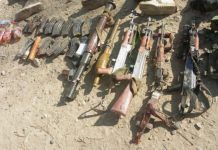DM Monitoring
KABUL: A panicked crush of people trying to enter Kabul’s international airport killed seven Afghan civilians in the crowds, the British military said on Sunday, showing the danger still posed to those trying to flee the Taliban’s takeover of the country. On Sunday, the British military acknowledged the deaths of seven civilians in the crowds in Kabul. There have been stampedes and crushing injuries in the crowds, especially as Taliban fighters fire into the air to drive away those desperate to get on any flight out of the country. “Conditions on the ground remain extremely challenging but we are doing everything we can to manage the situation as safely and securely as possible,” the defence ministry said in a statement.
Thousands rushed the airport last Monday in the chaos that saw the US try to clear off the runway with low-flying attack helicopters. Several Afghans plunged to their deaths while hanging off the side of a US military cargo plane. It’s been difficult to know the full scale of the deaths and injuries from the chaos. The Biden administration is considering calling on US commercial airlines to provide planes and crews to assist in transporting Afghan refugees once they are evacuated from their country by military aircraft. Under the voluntary Civil Reserve Air Fleet programme, civilian airlines add to military aircraft capability during a crisis related to national defence. That programme was born in the wake of the Berlin airlift.
The US Transportation Command said on Saturday it had issued a warning order to US carriers on Friday night on the possible activation of the programme. If called upon, commercial airlines would transport evacuees from way stations outside Afghanistan to another country or from Virginia’s Dulles International Airport to US military bases. Sunday’s deaths come as a new, perceived threat from the Islamic State (IS) group affiliate in Afghanistan is forcing the US military to develop new ways to get evacuees to the airport in Kabul, a senior US official said on Saturday, adding a new complication to the already chaotic efforts to get people out of the country. The official said that small groups of Americans and possibly other civilians will be given specific instructions on what to do, including movement to transit points where they can be gathered up by the military. The official spoke on condition of anonymity to discuss military operations.
Other measures in face of the potential IS threat include US military planes doing rapid, diving combat landings at the airport surrounded by Taliban fighters. Other aircraft have shot off flares on takeoff, an effort to confuse possible heat-seeking missiles targeting the planes. Officials declined to provide more specifics about the IS threat but described it as significant. They said there have been no confirmed attacks as yet by the militants, who have battled the Taliban in the past.
The changes come as the US Embassy issued a new security warning on Saturday telling citizens not to travel to the Kabul airport without individual instruction from a US government representative. Time is running out ahead of President Joe Biden’s August 31 deadline to withdraw most remaining US troops. In his remarks on the situation on Friday, he did not commit to extending it, though he did issue a new pledge to evacuate not only all Americans in Afghanistan but also the tens of thousands of Afghans who have aided the war effort since September 11, 2001. That promise would dramatically expand the number of people the US evacuates.
Biden faces growing criticism as videos depict pandemonium and occasional violence outside the airport, and as vulnerable Afghans who fear the Taliban’s retaliation send desperate pleas not to be left behind. The Islamic State group, which has long declared a desire to attack America and US interests abroad, has been active in Afghanistan for a number of years, carrying out waves of horrific attacks, mostly on the Shia minority. The group has been repeatedly targeted by US airstrikes in recent years, as well as Taliban attacks. But officials say fragments of the group are still active in Afghanistan, and the US is concerned about it reconstituting in a larger way as the country comes under divisive Taliban rule.
Despite the US Embassy warning, crowds remain outside the Kabul airport’s concrete barriers, clutching documents and sometimes stunned-looking children, blocked from flight by coils of razor wire. Evacuations continued, though some outgoing flights were far from full because of the airport chaos. The German military said in a tweet that one plane left Kabul on Saturday with 205 evacuees, while a second aircraft carried only 20. The Italian Defense Ministry announced the evacuation on Saturday of 211 Afghans, which it said brought to 2,100 the number of Afghan workers at Italian missions and their families who have been safely evacuated.
On Friday, British Prime Minister Boris Johnson said around 1,000 people a day were being evacuated amid a “stabilisation” at the airport. But on Saturday, a former Royal Marine-turned charity director in Afghanistan said the situation was getting worse, not better. “We can’t leave the country because we can’t get into the airport without putting our lives at risk,” Paul Farthing told BBC radio. Army Major General Hank Taylor, Joint Staff deputy director for regional operations, told Pentagon reporters on Saturday that the US has evacuated 17,000 people through the Kabul airport since Aug 15. About 2,500 have been Americans, he said.
US officials have estimated there are as many as 15,000 Americans in Afghanistan, but acknowledge they don’t have solid numbers. In the past day, about 3,800 civilians were evacuated from Afghanistan through a combination of US military and charter flights, Taylor said. Three flights of Afghan evacuees have arrived at Dulles International Airport outside Washington, DC. The evacuations have been hampered by screening and logistical strains at way stations such as al-Udeid Air Base in Qatar. US officials said they have limited numbers of screeners, and they are struggling to work through glitches in the vetting systems.
Taylor said that the Kabul airport remains open and that Americans continue to be processed if they get to the gates, but he and Pentagon spokesman John Kirby said the threat picture changes by the hour. “We know that we’re fighting against both time and space,” Kirby said. “That’s the race we’re in right now.” So far, 13 countries have agreed to host at-risk Afghans at least temporarily, US Secretary of State Antony Blinken said. Another 12 have agreed to serve as transit points for evacuees, including Americans and others. “We are tired. We are happy. We are now in a safe country,” one Afghan man said upon arrival in Italy with 79 fellow citizens, speaking in a video distributed by that country’s defence ministry. But the growing question for many other Afghans is, where will they finally call home? Already, European leaders who fear a repeat of the 2015 migration crisis are signalling that fleeing Afghans who didn’t help Western forces during the war should stay in neighbouring countries instead.
Remaining in Afghanistan means adapting to life under the Taliban, who say they seek an “inclusive, Islamic” government, will offer full amnesty to those who worked for the US and the Western-backed government and have become more moderate since they last held power from 1996 to 2001. They also have said, without elaborating, that they will honour women’s rights within the norms of Islamic law. But many Afghans fear a return to the Taliban’s harsh rule in the late 1990s, when the group barred women from attending school or working outside the home, banned television and music, chopped off the hands of suspected thieves and held public executions.
“Today, some of my friends went to work at the court and the Taliban didn’t let them into their offices. They showed their guns and said, ‘You’re not eligible to work in this government if you worked in the past one,’” one women’s activist in Kabul told The Associated Press on Saturday. She spoke on condition of anonymity for fear of retaliation. With a Turkish visa but no way to safely reach the airport, the activist described the gap between the Taliban’s words and actions as “very alarming.”




